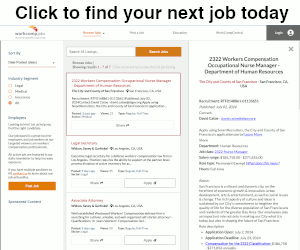Montgomery: No, Doctors Aren't the Culprits
Tuesday, September 17, 2024 | 0
It’s time to take a sledgehammer to one of the most pernicious myths about workers’ comp in California.

Catharine Montgomery
For decades, the Division of Workers’ Compensation has fed legislators the same line: Workers’ comp is a mess because doctors commit fraud.
According to the DWC, the efforts and resources of legislators should focus primarily on combating physician fraud because dastardly doctors are sucking up employers’ dollars by exaggerating diagnoses, over-treating and otherwise draining the system.
A recent comment on one of our blog articles echoed this tired sentiment. We consider this a teachable moment.
California’s workers’ comp system is collapsing under the weight of regulatory mismanagement and the laissez-faire policies of the DWC, which allows profiteering by claims administrators, sidekick vendors and their private equity owners. Scapegoating doctors, who struggle to make workers’ comp financially sustainable, let alone profitable, will solve nothing.
Read on and marvel at this deeply misinformed commenter trooping out false accusations based on anecdotal evidence (spewed by the DWC) rather than publicly available data.
The original article lamented the absurdly long claim durations in California compared to other states (seven years compared to three in the median state).
This article demonstrated how this “inefficiency” is simply profitable friction for certain entities, particularly third-party administrators, bill review companies, utilization review organizations, preferred provider organizations and other network discount peddlers — and, most importantly, private equity firms with investments across these businesses.
We also pointed out (for roughly the 12,000th time) that the DWC does absolutely nothing to address this “inefficiency,” even when faced with hard evidence of patterns of noncompliance by claims administrators like Sedgwick.
Yet one reader felt compelled to defend those who profit from workers’ comp dysfunction by dropping a predictable whataboutism: What about providers?
“You cannot when you omit two biggest delay drivers: applicant attorneys and the medical providers (your customers) who stand to profit more than any other party from delays.”
Putting aside the mystery of what we “cannot” do according to this word salad, let’s present the facts about who stands to profit.
First, attorneys on both sides profit from the system’s deficiencies. Attorney fees are a massive chunk of nonmedical expenses in workers’ comp, but they are certainly not limited to applicant attorneys’ fees. Payers have deep pockets and highly paid lawyers at their disposal, as anyone who’s had to fight legal battles for access to care can attest.
We routinely publish articles about how financially precarious treating injured workers is, thanks mainly to PPO discounting, which reduces payment to lower-than-Medicare rates despite the extraordinary practice expenses involved. Currently, our public reimbursement data page shows that providers are collectively paid at about 83% of fee schedule rates.
In California, it costs 49 cents in administrative expenses to deliver every dollar’s worth of actual benefits to injured workers — money that goes largely to claims administrators, their sidekick vendors and private equity firms.
The idea that providers are raking in profits from the treatment of injured workers is so profoundly misinformed as to be farcical.
It’s far from plausible that doctors in California treat injured workers because it’s a good revenue stream; quite the opposite, as demonstrated by practice closures and/or retreats from workers’ comp. The doctors who are still willing to see injured workers do so despite the financial reality, not because of it.
Where the profit goes
Meanwhile, there’s little question as to who’s truly profiting in workers’ comp. Business Wire reports on the workers’ comp insurers’ “Winning Streak” as workers’ comp “continues to outperform every other line of business in the U.S. property/casualty (P/C) industry.” Per global credit rating agency AM Best, Business Wire reports that:
"... the workers’ compensation line has been more profitable than any other personal or commercial line of business since 2015."
In California, private equity firm Carlyle invested $6.7 billion in TPA Sedgwick, which is now valued at $13.2 billion. Carlyle also presides over nebulous webs of bill review entities and network discounting companies, including MedRisk, Medata, Conduent and more — all siphoning their share of the 49 cents spent to deliver every dollar’s worth of benefits to injured workers.
It’s apparent to any objective observer who is making money from the dysfunction, and it certainly isn’t providers.
Sadly, this entire scheme is enabled by the regulatory body that should be protecting injured workers and their doctors: the DWC. This state agency turns its blind eye to scores of companies leeching billions in profit from the system year after year, openly declaring compliance with laws and regulations “voluntary” for payers while blatantly ignoring laws that require the DWC to take action.
In this fog of lawlessness and opacity, it’s easy to malign and demonize providers, who have relatively little influence over state policy compared to insurers, TPAs and private equity firms. With legislators and the public thus distracted, the lucrative game goes on.
Catherine Montgomery is the co-founder and CEO of daisyBill, a provider of workers' comp end-to-end revenue cycle management software. This post appears with permission.




Comments